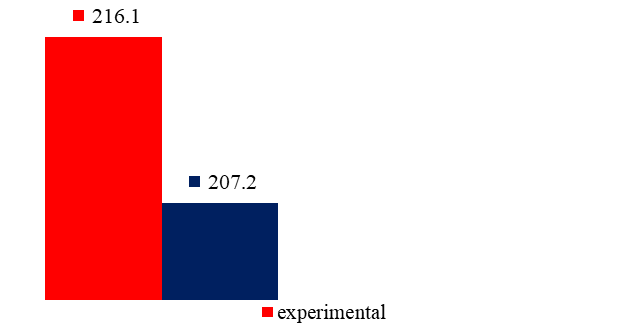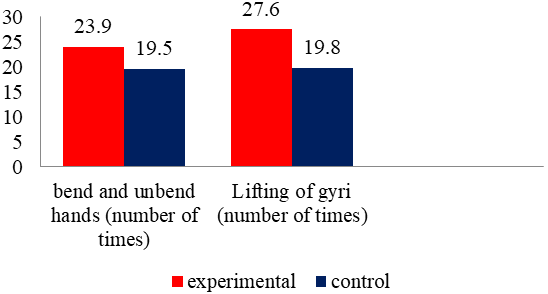Abstract
One of the tasks of the national model of the Russian physical culture and sports movement is the implementation in national schools of national and popular systems of physical education, which allow developing and using the national traditions of the peoples of Russia, their identity within the framework of a unified state system. It should be noted that strength is one of the most important physical qualities, ensuring the success of not only mastering the technique of exercise, but also achieving high results. The results of a stating experiment indicate that the development of strength in students is of particular concern. This conclusion is confirmed by testing indicators of All Russian Physical Culture Sport Committee (ARPCSC) GTO (16-17 years old). The content of the article presents one of the ways to solve the urgent problem of our time, which physical education teachers often encounter when organizing strength training with high school students, is the introduction of elements of the Russian athlete kettlebell sport. In the process of training, not only the necessary physical qualities (strength and endurance) are brought up, posture and a beautiful physique are formed, but also a favorable psychological microclimate is created in the process of achieving success. As part of the formative experiment, a set of exercises with kettlebells was developed and tested for the development of strength in 11th grade students. The results of the formative experiment convincingly prove the positive dynamics in the development of strength and strength abilities of high school students.
Keywords: Physical educationdevelopmentstrengthpedagogy of successhigh school studentsexercises with a kettlebell
Introduction
Russia is considered the place of origin and development of kettlebell lifting, that is why kettlebell lifting is recognized as our national sport. The beginning of the development of kettlebell lifting can be considered the end of the 17th century, when kettlebells of 16, 24, 32 kg were used to demonstrate strength and stride at various holidays (Vatel & Gray, 2005). Today we can say that weights are one of the oldest projectiles for strength training, created several thousand years ago. The search for new methods of organization of training with weights has been going on since when kettlebell lifting ceased to be a national "fun".
Since ancient times, a man with heroic strength enjoyed special respect in Russia. In Russia, folk tales glorified heroes-heroes, to whom phenomenal power was attributed, they were legends. The period from the 10th to the 19th centuries is characterized in Russia by spontaneous and unorganized occupations of the population by exercises with weights (Tikhonova, Makarov, & Maltseva, 2019).
In kettlebell lifting, the main physical qualities are strength and endurance, as well as classical and specially-auxiliary exercises with weights, effectively strengthen the cardiovascular, respiratory systems of the body and the musculoskeletal system. At senior school age, young men have favorable opportunities for the education of such a quality as strength. Let us consider the definition of “strength” as a person’s ability to overcome external resistance or resist it due to muscle effort (tension). And strength abilities are a complex of various manifestations of a person in a certain motor activity, which is based on the concept of “strength” (Shafikova & Greb, 2018).
The topic is relevant, as much is said about the poor physical fitness of students and military age youth both on television and in the press. However, instead of simple national sports available to the people, expensive overseas species are often promoted, which in no way can affect the solution of physical education problems in our country.
Note that a 16 kg weight spurt as a type of test (test) is included in the alternative part of ARPCSCGTO. The type of test is intended for grades V - IX; this is the age category into which high school student’s fall (Nagovitsyn, Rassolova, Senator, & Torbina, 2016).
It must be recognized that officially the abilities and the correct handling of weights are vital, and kettlebell lifting (or individual exercises with weights) is an effective, simple and affordable way to learn these skills and solve other problems of physical education of students and military age youth (Dmytro et al., 2017; Filimonova, Sabirova, Grishina, & Fedoryachenko, 2017).
Problem Statement
One of the ways to optimize the educational process in physical education is to search for rational approaches to physical education and health of students, the development of strength and strength endurance with the use of kettlebell lifting exercises in physical education lessons (Prontenko et al., 2017). We set the following tasks: to study scientifically - methodical literature on the research problem; to develop and test an experimental set of exercises with weights for the development of strength in students of 11th grade; to evaluate the impact of the exercises with weights on the change in the level of strength development in high school students in physical education lessons.
Research Questions
In our opinion, the development of kettlebell lifting in modern Russia is haphazard. How to teach children to lift weights and weights in schools if physical education teachers have no idea about this sport? Kettlebell lifting specialists are nowhere to be trained; in the specialized scientific literature, the tools for using kettlebell lifting in physical education are not well represented.
In the course of the analysis of scientific and methodological literature, the following issues were considered: characteristics of the age peculiarities of high school children; the essence of the concept of strength as the physical qualities of a person is determined, the means and methods of development are identified in the context of the application of classical and specially-auxiliary exercises with a weight.
Purpose of the Study
The purpose of our work is to develop and test a set of exercises with a kettlebell that ensures the development of strength in high school students in physical education lessons.
Research Methods
The following research methods were used in this work: analysis of scientific and methodological literature, testing, and pedagogical experiment, mathematical and statistical data processing.
The analysis of scientific and methodological literature made it possible to concretize the goal, tasks, hypothesis, and select research methods.
Testing. To assess the level of strength development at the stages of our pedagogical experiment, we used the following tests recommended by the ARPCSC GTO for students 16-17 years old (V stage): a long jump from one place with a push with two legs, bending and unbending the arms while lying down, jerking a kettlebell.
The pedagogical experiment was aimed at increasing the level of strength development in children of high school age, through the use of exercises with weights in the main part of the lesson. Our study was carried out on the basis of MAEI Gymnasium "Istok" of Veliky Novgorod. Students of 11A and 11B classes took part in the experiment. 2 groups (control and experimental) of 10 people each were formed.
The study was conducted in three stages. At the preparatory stage, we carried out an analysis of literary sources on the research problem, a conversation with teachers of a secondary school about the problems of physical education of high school children, developed and composed sets of exercises with weights.
At the formative stage of the study, students of the experimental class studied and improved the technique of exercises with kettlebells, which were carried out in the main part of the lesson and were designed for 8 weeks of classes, one complex was conducted for each week. The control group was engaged on the basis of the "Comprehensive program of physical education for students in grades 1-11", with the same number of lessons per week. Traditional exercises for developing strength were presented in the content of lessons in both classes in accordance with thematic planning.
Next, we consider the methodological features of the application of classical and specially-auxiliary exercises with a kettlebell, which must be taken into account when conducting physical education lessons with high school students (Kostiantyn еt al., 2016; Kostiantyn еt al., 2017; Kuzmin, 2003):
the complexity of the exercises gradually increases, at the end some exercises begin to be repeated, which allows not only to repeat them, but also to perform at a higher quality level, taking into account the existing experience;
you can increase the weight of the kettlebells and perform exercises with a higher load;
in all exercises, large muscle groups work most of all: legs, back. Alsothe abs, arms (shoulders, biceps and triceps), chest are included;
for lessons with weights in class 10-15 minutes are given, exercises are performed in 1-3 approaches;
the lesson is held in a certain rhythm, where students are divided into pairs, approximately equal in strength. One student performs the exercise, the second rests, and vice versa, the duration of one rest is equal to the time the partner performed the exercise;
the pulse should be in the range 140-170 beats / min, after the exercise the pulse should not exceed
170 beats / min, and at the end of the rest - not lower than 140 beats / min. If the pulse is higher than indicated, it is necessary to reduce the kettlebells weight or reduce the number of repetitions;
exercises to perform correctly according to the technique of tracking the breath.
During the control phase, a final test was conducted of the development of strength of children of high school age, mathematical and statistical processing of the results was performed, and the obtained data were analyzed.
To assess the effectiveness of the pedagogical impact, we used Student's t-test.
Findings
The results of the control tests before the experiment are presented in Figure

In all control tests t calc. turned out to be less than t tab., which indicates the unreliability of differences in the results of the first and second groups.
The results of control testing after the experiment are presented in Figures


The calculation of the significance of differences in the results of the two groups by the Student t- criterion showed that the changes are significant for all indicators. In the exercise "Long jump" tculc.>ttabl.(2.91> 2.09); in the exercise “Flexion and extension of the arms in a lying position” (2.12> 2.09); in exercise “Dumbbell pull” (3.39> 2.09). As can be seen from the results, the dynamics of the indicators in the experimental group are more pronounced. The dynamics of the strength development is presented in Table
The data of our theoretical and experimental research show that the hypothesis posed at the beginning of our study is confirmed, namely, that the use of kettlebell lifting exercises in high school classes will positively affect the level of strength development in high school students.
Conclusion
In our work, we substantiated and verified the effectiveness of the developed experimental set of exercises for developing strength using kettlebell lifting equipment. As a result of the tests, which consisted of exercises of the ARPCSC GTO complex for students aged 16-17 (V stage), we found that young men in the experimental group had a higher increase in strength development at the end of the study than young men in the control group. So, in the long jump from a place, the result of the experimental group improved by 11,8%, and among young men in the control group by 1.6%. The gain in the snatch of 16 kg for 4 minutes in the experimental group was 9.2% versus 0.9% of the control group, and the increase in flexion and extension of the arms while lying down, respectively, was 5.2% and 1.1%.
Thus, the result of the use of experimental sets of exercises with a kettlebell was an increase in the level of strength training of the young men of the experimental group, which allowed them to improve the results when fulfilling the proposed standards of the ARPCSC GTO complex for students 16-17 years old (V stage).
Analysing the results of our pedagogical experiment, it can be argued that the developed experimental sets of exercises with weights have a positive effect on the level of strength development in boys of grades 10-11, and weight-lifting equipment can be successfully used in training such a physical quality as strength.
References
- Dmytro, K., Rostislav, R., Oleksandr, K., Kostiantyn, P., Vasyl, P., & Valentin, B., & Iurii, I. (2017). Development of the physical qualities of future specialists in protective activities due to the use of the kettlebell sport during studies. Journal of Physical Education and Sport, 2, 789-796.
- Filimonova, S. I., Sabirova, I. A., Grishina, T. S., & Fedoryachenko, S. N. (2017). GTO complex role in national physical culture and sports sector. Theory and Practice of Physical Culture, 4(31).
- Kostiantyn, P., Vasyl, P., Volodymyr, K., Valentin, B., Oleksandr, H., Sergiy, B., & Volodymyr, A. (2017). Technical preparedness of sportsmen in the kettlebell sport. Journal of Physical Education and Sport, 1, 28-33.
- Kostiantyn, P., Vasyl, P., Volodymyr, A., Volodymyr, M., Igor, R., Valentin, B., & Sergiy, B. (2016). Improvement of physical preparedness of sportsmen in kettlebell sporton the stage of the specialized base preparation. Journal of Physical Education and Sport, 2, 540-545.
- Kuzmin, A. A. (2003). Kettlebell Sport: Iron Sport for Iron Men. Methods of training by Andrey Kuzmin. Ohio.
- Nagovitsyn, R. S., Rassolova, E. A., Senator, S. Yu., & Torbina, I. I. (2016). Development of a web portal for preparing students for testing according to GTO standards. Theory and practice of physical education, 1, 39-42. [in Russ.].
- Prontenko, K., Prontenko, V., Griban, G., Kostyuk, Y., Zhukovskyi, Y., Andreychuk, V., & Tkachenko, P. (2017). Kettlebell lifting as a means of physical training of cadets at the higher military educational institution. Journal of Physical Education and Sport, 4, 2685-2689.
- Shafikova, L. R., & Greb, A. V. (2018). Development of strength abilities in students involved in weightlifting. Theory and practice of physical education, 6, 45-46. [in Russ.]
- Tikhonova, A. Yu., Makarov, D. V., & Maltseva, A. P. (2019). Folk outdoor games as a means of familiarizing with the cultural heritage of the region. Theory and practice of physical education, 2, 8-10. [in Russ.].
- Vatel, S., & Gray, V. D. (2005). Kettlebells: strength training for power and grace. New York: Sterling Publishing.
Copyright information

This work is licensed under a Creative Commons Attribution-NonCommercial-NoDerivatives 4.0 International License.
About this article
Publication Date
26 August 2020
Article Doi
eBook ISBN
978-1-80296-086-0
Publisher
European Publisher
Volume
87
Print ISBN (optional)
-
Edition Number
1st Edition
Pages
1-812
Subjects
Educational strategies, educational policy, teacher training, moral purpose of education, social purpose of education
Cite this article as:
Kirsanova, O. N. (2020). Kettlebells Exercises As A Means Of Strength Development Of High School Students. In S. Alexander Glebovich (Ed.), Pedagogical Education - History, Present Time, Perspectives, vol 87. European Proceedings of Social and Behavioural Sciences (pp. 562-568). European Publisher. https://doi.org/10.15405/epsbs.2020.08.02.74

